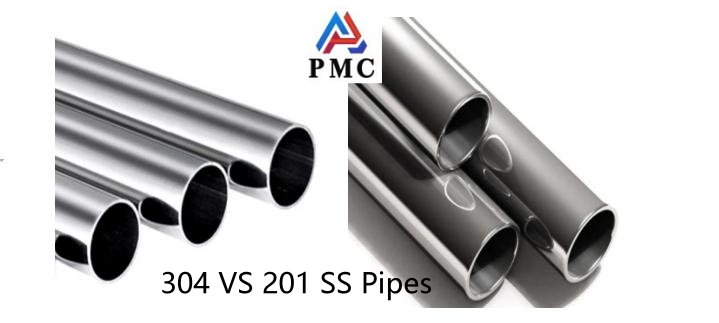
Difference between 304 and 201 Stainless Steel Pipes
1. Material composition analysis
201 stainless steel belongs to austenitic stainless steel, and its main components include:
Nickel: low, generally between 3% and 5%.
Chromium: usually between 16% and 18%,
Manganese: high content, generally between 5% and 7.5%.
Silicon and carbon: relatively low.
Compared with 304 stainless steel, 201 stainless steel relies more on manganese to improve corrosion resistance, which is one of the important reasons for its lower cost.
304 stainless steel is a more common food-grade stainless steel, and its composition is usually:
Nickel: 8%~10.5%
Chromium: 18%~20%
The content of silicon, manganese, carbon and other elements is relatively low. 304 stainless steel is widely used in catering, medical and chemical industries due to its excellent corrosion resistance and excellent formability.

2. Corrosion resistance
Corrosion resistance of 201 stainless steel
Due to the relatively low nickel content of 201 stainless steel, its corrosion resistance is inferior to that of 304 stainless steel. It is prone to surface oxidation and even rust when in a humid environment or in contact with certain chemicals. In marine environments or highly corrosive chemical environments, 201 stainless steel has weaker adaptability and its service life will be greatly reduced.
Corrosion resistance of 304 stainless steel
304 stainless steel has better corrosion resistance, mainly due to its higher nickel and tantalum content. In most cases, it can resist oxidation, chemical corrosion and erosion by various foods. 304 stainless steel is widely used in highly corrosive environments such as kitchens, medical facilities, and chemical equipment, and its service life is longer.
3. Cost and Economics
Cost of 201 stainless steel
Due to the low nickel content of 201 stainless steel, its production cost is relatively low, so it is also cheaper in the market. This makes 201 stainless steel pipe an ideal choice for some construction and engineering projects with limited economic budgets.
Cost of 304 stainless steel
However, 304 stainless steel is expensive due to its excellent performance and high production cost. Therefore, when choosing materials, it is necessary to comprehensively consider the project budget and usage requirements. Although the initial investment of 304 stainless steel is high, in the long run, its durability and low maintenance cost make it a high-quality material worth investing in.
4. Physical properties
Whether it is 201 or 304 stainless steel pipes, they have some common advantages in physical properties.
High strength: The tensile strength of both can meet the common pressure requirements.
Good formability: Stainless steel pipes are relatively easy to process and can be made into various shapes through stamping, bending and other processes.
5. Application areas
201 stainless steel pipes are widely used in general industrial pipelines, drainage systems and some occasions that do not come into contact with food and highly corrosive media. Especially in some buildings and home decorations, they are also common because of their beautiful appearance and affordable price.
In contrast, 304 stainless steel pipes are suitable for a wider range of fields.
Food industry: such as food processing, water treatment facilities, etc.
Medical industry: used to make surgical instruments and medical equipment, requiring the hygiene and corrosion resistance of stainless steel.
Chemical industry: used for chemical reaction equipment, storage tanks, etc., and need to withstand the erosion of various chemicals.
6. Maintenance and care
Although 201 stainless steel is cheaper, it requires special care during use. Avoid exposing it to humid environments and check it regularly to prevent rust. The maintenance of 304 stainless steel is relatively simple, daily cleaning of the surface is sufficient, and in most cases, no complicated maintenance and care is required. And its corrosion resistance is strong, and it can maintain good performance for a long time.
7. Simple and convenient way to distinguish 304 and 316 stainless steel pipes
We can first identify them by looking with the naked eye and touching them with our hands. 304 stainless steel has a very good luster to the naked eye and is very smooth to the touch; 201 stainless steel pipe is dark in color and has no luster, and feels rough and not smooth to the touch. In addition, wet your hands with water and touch the two types of stainless steel plates respectively. After touching, the water stains and handprints on the 304 stainless steel pipe are easier to wipe off, while the 201 is not easy to wipe off.
Second, use a grinder equipped with a grinding wheel to gently grind the two plates. When grinding, the sparks of 201 plate are relatively long, thick, and numerous, while the sparks of 304 stainless steel are relatively short, thin, and few. The force must be light when grinding, and the two grinding forces must be consistent for easy distinction.
Third, apply stainless steel pickling solution to two types of stainless steel decorative pipes. After 2 minutes, observe the color change of the stainless steel where it is applied. If the color turns black, it is 201, and if it turns white or does not change color, it is 304 stainless steel pipe.
Read more: 304 and 316 Stainless Steel Pipes, Which One is Better?


